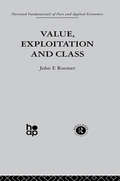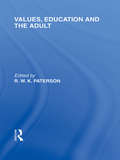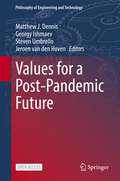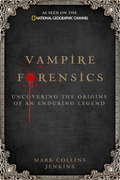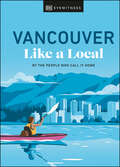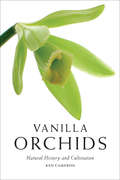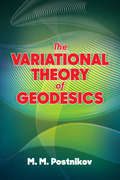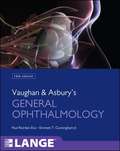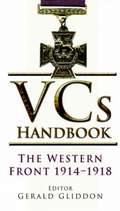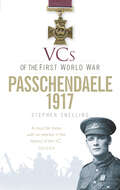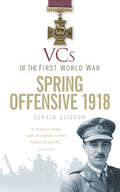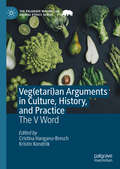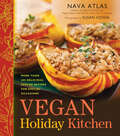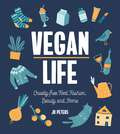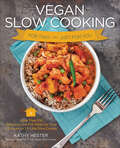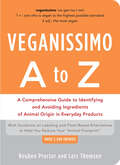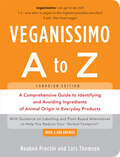- Table View
- List View
Value, Exploitation and Class
by J. RoemerJohn E. Roemer, one of the founders of analytical Marxism, draws on contemporary mathematical economics to put forward a refined extension of the Marxian theory of exploitation, labour value and class.
Values, Education and the Adult (International Library of the Philosophy of Education Volume 16)
by R.W.K. PatersonIn this study of the main conceptual and normative issues to which the education of the adult gives rise, the author demonstrates that these issues can be understood and resolved only by coming to grips with some of the central and most contentious questions in epistemology, philosophy of mind, ethics, and social philosophy. A salient feature of the book is its searching examination of the different types of value judgement by which all educational discourse is permeated. The analysis of the nature and justification of educational judgements forms the basis of an overall philosophy of adult education which should provide a much needed axiological framework for the guidance of practitioners in this growing area of educational concern.
Values for a Post-Pandemic Future (Philosophy of Engineering and Technology #40)
by Matthew J. Dennis Georgy Ishmaev Steven Umbrello Jeroen van den HovenThis open access book shows how value sensitive design (VSD), responsible innovation, and comprehensive engineering can guide the rapid development of technological responses to the COVID-19 crisis. Responding to the ethical challenges of data-driven technologies and other tools requires thinking about values in the context of a pandemic as well as in a post-COVID world. Instilling values must be prioritized from the beginning, not only in the emergency response to the pandemic, but in how to proceed with new societal precedents materializing, new norms of health surveillance, and new public health requirements.The contributors with expertise in VSD bridge the gap between ethical acceptability and social acceptance. By addressing ethical acceptability and societal acceptance together, VSD guides COVID-technologies in a way that strengthens their ability to fight the virus, and outlines pathways for the resolution of moral dilemmas. This volume provides diachronic reflections on the crisis response to address long-term moral consequences in light of the post-pandemic future. Both contact-tracing apps and immunity passports must work in a multi-system environment, and will be required to succeed alongside institutions, incentive structures, regulatory bodies, and current legislation. This text appeals to students, researchers and importantly, professionals in the field.
Vampire Forensics: Uncovering the Origins of an Enduring Legend
by Mark Collins JenkinsJenkins navigates centuries of lore and legend, adding new chapters to the chronicle and weaving an irresistibly seductive blend of superstition, psychology, and science sure to engross everyone from Anne Rice's countless readers to serious students of archaeology and mythology.
Vancouver Book of Everything: Everything You Wanted to Know About Vancouver and Were Going to Ask Anyway (Book Of Everything Ser.)
by Samantha AmaraThe go-to book on Canada&’s west coast gem—from affordable activities to crime and punishment, slang to weather, people to politics, and much more. From &“Gassy&” Jack Deighton and the Klondike Gold Rush to the Chinese Head Tax to Japanese Internment, the Strathcona Protest, Vancouver Canucks and the 2010 Olympic Winter Games to profiles of the original &“Dominic Da Vinci,&” Larry Campbell, famed author Douglas Coupland, and environmentalist David Suzuki, no book is more comprehensive than the Vancouver Book of Everything. No book is more fun. Well-known Vancouverites weigh in on every aspect of their beloved city. Historian Chuck Davis gives us his top five events that shaped its history; author Jen Sookfong Lee gives us her top five best things about living in Vancouver; Vancouver Sun restaurant critic Mia Stainsby gives us the city&’s top five cheap eats and Global TV&’s meteorologist, Mark Madryga, offers up his top five Vancouver weather events. From the city&’s First People and infamous weather to its slang, heinous crimes, and the ubiquitous Japa dog, it&’s all here. Whether you are a lifelong resident or visiting for the first time, there is no better resource about the city of Vancouver, you&’ll love the Vancouver Book of Everything. &“Even born-and-bred Vancouverites will doubtless find something of interest in the Vancouver Book of Everything.&” —The Westender &“The book combines tourist elements . . . with facts that even seasoned Vancouverites may not know.&” —Miss604 &“When your friends start asking questions about the city, hand them the Vancouver Book of Everything.&” —Vancouver Sun
Vancouver Like a Local: By the People Who Call It Home (Local Travel Guide)
by Jacqueline Salome Lindsay Anderson Vivian Chung Aleem Kassam Michael WhiteKeen to explore a different side of Vancouver? Like a Local is the book for you.This isn&’t your ordinary travel guide. Beyond Vancouver&’s beautiful scenery are stylish vintage stores, cozy wine bars and awesome art spaces that locals love – and that&’s where this book takes you. Turn the pages to discover:The small businesses and community strongholds that add character to this vibrant city, recommended by true locals6 themed walking tours dedicated to specific experiences such as craft breweries and a night out in GastownA beautiful gift book for anyone seeking to explore VancouverHelpful what3word addresses, so you can pinpoint all the listed sightsCompiled by five proud Vancouverites, this stylish travel guide is packed with Vancouver&’s best experiences and secret spots, handily categorized to suit your mood and needs.Whether you&’re a restless Vancouverite on the hunt for a new hangout, or a visitor keen to discover a side you won&’t find in traditional guidebooks, Vancouver Like A Local will give you all the inspiration you need. About Like A Local:These giftable and collectable guides from DK Eyewitness are compiled exclusively by locals. Whether they&’re born-and-bred or moved to study and never looked back, our experts shine a light on what it means to be a local: pride for their city, community spirit and local expertise. Like a Local will inspire readers to celebrate the secret as well as the iconic – just like the locals who call the city home. Looking for another guide to Vancouver? Explore further with our Top 10 guide to Vancouver and Vancouver Island.
Vanilla Orchids: Natural History and Cultivation
by Ken CameronWith more than 30,000 known species, orchids represent the largest family of plants. But only one genus has agricultural value—the Vanilla orchid. Leading orchid expert Ken Cameron covers the natural history of the world’s most popular flavor and fragrance and provides an introduction to the pollination, biology, structure, evolution, and diversity of Vanilla and related orchids. Vanilla Orchids also features methods for bean harvest, curing, and processing for enthusiasts who want to try it at home.
The Variational Theory of Geodesics (Dover Books on Mathematics)
by M. M. PostnikovRiemannian geometry is a fundamental area of modern mathematics and is important to the study of relativity. Within the larger context of Riemannian mathematics, the active subdiscipline of geodesics (shortest paths) in Riemannian spaces is of particular significance. This compact and self-contained text by a noted theorist presents the essentials of modern differential geometry as well as basic tools for the study of Morse theory. The advanced treatment emphasizes analytical rather than topological aspects of Morse theory and requires a solid background in calculus.Suitable for advanced undergraduates and graduate students of mathematics, the text opens with a chapter on smooth manifolds, followed by a consideration of spaces of affine connection. Subsequent chapters explore Riemannian spaces and offer an extensive treatment of the variational properties of geodesics and auxiliary theorems and matters.
The Varieties of Psychedelic Experience: The Classic Guide to the Effects of LSD on the Human Psyche
by Jean Houston Robert MastersOne of the most important books written on the effects of LSD on the human psyche. • Its authoritative research has great relevance to the current debate on drug legalization. • Prolific authors Robert Masters and Jean Houston are pioneer figures in the field of transpersonal psychology and founders of the Human Potentials Movement. The Varieties of Psychedelic Experience was published in 1966, just as the first legal restrictions on the use of psychedelic substances were being enacted. Unfortunately, the authors' pioneering work on the effects of LSD on the human psyche, which was viewed by its participants as possibly heralding a revolution in the study of the mind, was among the casualties of this interdiction. As a result, the promising results to which their studies attested were never fully explored. Nevertheless, their 15 years of research represents a sober and authoritative appraisal of what remains one of the most controversial developments in the study of the human psyche. Avoiding the wild excesses taken by both sides on this issue, this book is unique for the light it sheds on the possibilities and the limitations of psychedelic drugs, as well as on the techniques for working with them. With drug legalization an increasingly important issue, The Varieties of Psychedelic Experience provides a welcome and much needed contrast to the current hysteria that surrounds this topic.
Varmint Rifles and Cartridges: A Comprehensive Evaluation of Select Guns and Loads
by Charles T. RichardsA thorough guide, Varmint Rifles and Cartridges provides detailed information about getting started in varmint hunting, selecting the best rifles for the job, and choosing your cartridges and other components. The text is supplemented by more than one hundred detailed photographs that illustrate the various types of rifles and cartridges available for varmint hunters.Varmint Rifles and Cartridges presents information about the history of varmint hunting and how those original rifles differ from the most popular rifles and cartridges available for varmint hunters on the market today. Each chapter of the book is dedicated to a particular cartridge, including the: .204 Ruger .223 Remington .220 Swift .243 Winchester .257 RobertsAt the end of each chapter, author C. T. Richards demonstrates how each cartridge and rifle performs through the results of range tests and trajectory tests he conducted himself. A varmint hunter since the 1950s, Richards is more than qualified to grade these products and offer advice on varmint hunting in general.The content of Varmint Rifles and Cartridges will appeal to readers considering varmint hunting for the first time, as well those who have previously acquired some experience in using these tools.
Vaughan & Asbury's General Ophthalmology (Eighteenth Edition)
by Paul Riordan-Eva Emmett T. CunninghamGeneral Ophthalmology is a concise, current, and authoritative review of the subject for medical students, ophthalmology residents, practicing ophthalmologists, nurses, optometrists, and colleagues in other fields of medicine and surgery, as well as health-related professionals.
VCs Handbook: The Western Front 1914-1918
by Gerald GliddonOn the Western Front during the First World War, 490 men won the British Empire's highest award for gallantry, the Victoria Cross. A companion for any visitor to the First World War battlefields in France and Flanders, this reference book lists every VC recipient from 1914 to 1918 in alphabetical order.
VCs of the First World War: Passchendaele 1917 (VCs of the First World War)
by Stephen SnellingOf all the costly campaigns fought across the Western Front during the First World War, none strikes a more chilling chord than Passchendaele. Even now, more than ninety years on, the very mention of the name is enough to conjure up apocalyptic images of desolation and misery on a quite bewildering scale – humanity drowning in a sea of mud. Passchendaele has come to serve as a symbol of the folly and futility of war, chiefly remembered for its carnage and profligate waste of human lives. It also stands as testament to the endurance and extraordinary courage displayed by men of all ranks and nationalities. During the 3 ½ month long struggle, which claimed the lives of more than 60,000 British and Commonwealth servicemen, 61 men were adjudged to have performed deeds worthy of the Empire’s highest award for valour – the Victoria Cross. Men from Australia, Canada, New Zealand and South Africa were among their number, alongside men from England, Ireland, Scotland and Wales. They came from all walks of life, counting humble privates and, for the first time, a general among their ranks. This is a lasting memorial to a body of men who deserve to be numbered among the bravest of the brave.
VCs of the First World War: Spring Offensive 1918
by Gerald GliddonAt the end of 1917, after three years of trench warfare on the Western Front, the Allied armies of Britain and France, and those of their main opponent, Germany, had reached a point of exhaustion and hibernation. On March 21 1918, the German Army launched a massive assault on the Western Front, hurling fifty-nine divisions into battle against the British Fifth Army, smashing through British lines and advancing 40 miles per week. More offensives were to follow throughout the spring, including at Aisne and Marne, with the aim of ending the war before American forces could reach the Continent and reinforce the Allied lines. Nevertheless, although the German Army left the British Army reeling, the Tommies retreated in good order and fought all the way. It was during these bloody battles, which lasted until July 1918, that fifty-seven men stood out for acts of extraordinary daring and bravery. To these men the highest military honour was awarded – the Victoria Cross. This book reveals the true extent of their bravery, their backgrounds and their lives after the war.
Veg: The V Word (The Palgrave Macmillan Animal Ethics Series)
by Cristina Hanganu-Bresch Kristin KondrlikThis collection explores the arguments related to veg(etari)anism as they play out in the public sphere and across media, historical eras, and geographical areas. As vegan and vegetarian practices have gradually become part of mainstream culture, stemming from multiple shifts in the socio-political, cultural, and economic landscape, discursive attempts to both legitimize and delegitimize them have amplified. With 12 original chapters, this collection analyses a diverse array of these legitimating strategies, addressing the practice of veg(etari)anism through analytical methods used in rhetorical criticism and adjacent fields. Part I focuses on specific geo-cultural contexts, from early 20th century Italy, Serbia and Israel, to Islam and foundational Yoga Sutras. In Part II, the authors explore embodied experiences and legitimation strategies, in particular the political identities and ontological consequences coming from consumption of, or abstention from, meat. Part III looks at the motives, purposes and implication of veg(etari)anism as a transformative practice, from ego to eco, that should revolutionise our value hierarchies, and by extension, our futures. Offering a unique focus on the arguments at the core of the veg(etari)an debate, this collection provides an invaluable resource to scholars across a multitude of disciplines.
Vegan Holiday Kitchen: More than 200 Delicious, Festive Recipes for Special Occasions
by Nava Atlas“Vegans rejoice!” for this special occasion cookbook offering “vegan versions of traditional holiday foods . . . for everyone to enjoy.” (Epicurious.com)Have yourself a happy vegan holiday! This exciting, inviting cookbook by veteran author Nava Atlas brilliantly fills the biggest gap in the vegan repertoire with more than 200 delectable, completely doable recipes for every festive occasion. Atlas, one of the most respected names in vegetarian and vegan cooking, addresses everything from Thanksgiving, Hanukkah, and Christmas —to celebratory brunches, lunches, dinners, potlucks, and buffets. Such mouthwatering dishes as Coconut Butternut Squash Soup, Green Chili Corn Bread, Hearty Vegetable Pot Pie, delicate Ravioli with Sweet Potatoes and Sage, and Cashew Chocolate Mousse Pie will convince even the most skeptical eater that vegan cooking is well worth celebrating. ”Beloved winter holiday hits go meatless, including vegan holiday cookies spiced with cinnamon and ginger, mock chopped liver (cashew, onion and mushroom pate) and 'vegg' nog, thick and rich with almond milk and cashew butter, liberally spiked with rum. The spirit of the season remains but anything animal is excised.” —Huffington Post
Vegan Instant Pot Cookbook: 5 Ingredients Or Less - Quick, Easy, And Healthy Plant Based Meals For Your Family (Vegan Instant Pot Recipes Ser.)
by Brandon Parker<P>Would you like to create quick and delicious Vegan Recipes with only 5 Ingredients or Less? Would you like to recharge your body with healthy and nutrient rich vegan dishes without spending all day cooking? <P>If yes, then this book might be a perfect choice for you! <P>Thank you for considering, "Vegan Instant Pot Cookbook: 5 Ingredients or Less - Quick, Easy, and Healthy Plant Based Meals for Your Family." <P>There are still a lot of people out there who mistakenly believe that vegan food is boring, tasteless, and complicated to make. They usually base their assumption on the numerous highly processed, extremely tasteless, and very expensive vegan options like: garden "burgers," tofurkey, and veggie hotdogs. <P>No one is going to argue with how bad these three food options are. Even hard-core vegans avoid these like the plague. <P>Real vegan dishes are made from whole food, which is organically delicious, fragrant, and vibrantly colored. These are also cheaper to buy in bulk especially when you price-match these with celebrity-endorsed vegan options. With the help of the Instant Pot, affordable, delicious, and healthy all-vegetable meals can be cooked by simply pressing a couple of buttons. <P>If you are looking for budget-friendly recipes (vegan or otherwise,) you should really consider buying this book. All the recipes within contain only 5 ingredients or less. Many of which can be easily found in your local grocery stores or supermarkets. <P>This book contains 60+ vegan-safe recipes for breakfast, lunch, and dinner. These include everything from grain-based breakfast options, to easy soups, and to stick-to-your-ribs dinner selections. There are also healthy choices for those who love to munch on savory snacks in between meals, and those who love to give in to their sweet tooth. <P>Also included are easy-to-follow, no-cook recipes like: coconut butter, dairy-free pesto, flavored vinegars, and homemade vegan cheese. <P>Some of the benefits a Vegan diet: <br>Younger looking skin <br>Healthier hair and nails <br>Weight loss <br>Longer lifespan <br>Lower blood sugar levels <br>Improved kidney function <br>Protection against Cancer <br>Lower risk of heart disease <br>Reduced pain from arthritis <br>Increase in energy levels <br>Drop in Cholesterol <br>And the list goes on... <P>So what are you waiting for? Buy and download "Vegan Instant Pot Cookbook: 5 Ingredients or Less - Quick, Easy, and Healthy Plant Based Meals for Your Family" now!
Vegan Junk Food: From Apple Fritters and Candied Almonds to Pumpkin Pie and Maple Pecan Shortbread Bars, Your Favorite Vegan Treats Made Easy (Vegan Junk Food #2)
by Lane GoldTake the stress out of Thanksgiving with easy-to-prepare vegan treats sure to please any crowd!We all love gathering with family and friends to celebrate Thanksgiving. Make sure everyone can indulge in a tasty treat with these delicious, easy-to-make vegan treats perfect for your holiday celebrating! With these simple snack recipes, you can easily serve animal-friendly snacks made with love, including sweet treats like Pumpkin Pie with Bourbon Praline Sauce or Sugar Cookies. Gather round the table this holiday and enjoy the Vegan Junk Food: Thanksgiving Menu! Looking to enjoy vegan treats all year round? Check out Vegan Junk Food, Expanded Edition!
Vegan Junk Food, Expanded Edition: 200+ Vegan Recipes for the Foods You Crave—Minus the Ingredients You Don't (Vegan Junk Food Cookbook Series #2)
by Lane GoldWho said a vegan diet has to be boring—these healthy and satisfying twists on your favorite junk food let you have the best of both worlds! Have you committed to a vegan diet, but still find yourself dreaming of those taboo sugary, salty, and fried treats of your past? Don&’t panic—your old favorite junk foods may not be as bygone as you think… Vegan Junk Food, Expanded Edition proves that going vegan doesn&’t mean giving up your favorite comfort foods, or sustaining on plain broccoli and tofu every night of the week. With over 200 delicious (and animal-friendly!) twists on your favorite junk foods—from Loaded Nachos to Cheesy Kale Chips—you&’ll learn to make savory snacks that will satisfy your lingering cravings. Perfect for parties, snacks-on-the-go, or even late-night treats, these fun and easy recipes will impress friends and family alike—and might even inspire them to follow you on the path to a vegan lifestyle!
Vegan Life: Cruelty-Free Food, Fashion, Beauty and Home
by Jo PetersThere’s more to being vegan than eating your greens…A plant-based diet is the foundation of a vegan lifestyle, but you can do so much more to incorporate a cruelty-free approach into everyday life. Vegan Life highlights the simple, achievable ways you can show kindness to animals – and to the environment – not just with your choice of food but with the household products, clothing and cosmetics you buy too. With tips on how to reliably spot vegan goods when shopping, DIY ideas for making your own organic cosmetic and cleaning products and, of course, essential recipes for delicious vegan food, this book makes it easy to live more ethically.
Vegan Slow Cooking for Two or Just for You: More Than 100 Delicious One-Pot Meals for Your 1.5-Quart or 1.5-Litre Slow Cooker
by Kathy HesterA slow cooker cookbook “filled with fantastic recipes that are perfectly sized for smaller households” (Stephanie O’Dea, New York Times–bestselling author of Make it Fast, Cook it Slow).If you have a small family or are looking for better-portioned vegan meals (that don’t force you to eat chili for a week straight!), Vegan Slow Cooking for Two or Just for You is the perfect resource for you. Featuring recipes geared specifically for use with a 1.5- to 2-quart slow cooker, you’ll find endless meal ideas that you can make with minimal effort and maximum taste. Just prep a few items the night before or morning of, and come home to a hot meal—or side, or dessert—the moment you walk in the door! The little slow cooker is so easy to use that it makes cooking everyday a snap, so you can have a healthy variety of foods at a fraction of the cost of eating out. Inside, you’ll find a whole new world of food to fall in love with, from breakfast-y Pumpkin Polenta to comforting White Bean Quinoa Gumbo to luscious Blueberry Lemon Cake. You’ll be amazed at what your little slow cooker can do!“Hester presents a collection of unique small batch recipes, from breakfast to dessert. . . . accompanied by beautiful photographs, demonstrating that slow-cooked food can be vibrant and colorful. VERDICT: Vegans, vegetarians, and anyone seeking healthy, appetizing slow cooker recipes in small portions will find this title informative and inspiring.” —Library Journal
Veganissimo A to Z: A Comprehensive Guide To Identifying And Avoiding Ingredients Of Animal Origin In Everyday Products
by Reuben Proctor Lars Thomsenveganissimo \ve-gan-iss-i-mo\ 1. n : one who is vegan to the highest possible standard 2. adj : the most vegan An Essential New Resource for Those Who Want to Reduce Their “Animal Footprint” Substances obtained from animals are used everywhere—in food and other goods, in the production of food and goods, and (due to advances in biotech and genetic engineering) even in places they’ve never appeared before. Whether you already strive for a 100 percent vegan lifestyle or just want to know what exactly is in the products you buy, this peerless, portable guide puts the power of knowledge at your fingertips. The product of years of exhaustive research by vegan authors Reuben Proctor and Lars Thomsen, Veganissimo A to Z cuts through the vague and often misleading language on labels to reveal the sources, production and uses of over 2,500 ingredients, with: • Detailed A-to-Z entries on animal, vegetable, mineral, synthetic and microbiological substances—and color-coded icons that distinguish them at a glance • Information on animal-derived ingredients that lurk in food and other products—such as diet supplements, medicine, cosmetics, cleaning products, clothes, sporting goods, art supplies and electronics • And guidance on how to interpret label claims and seek more information. With this accessible reference, you’ll have all the information you need to make conscious decisions about a wide range of products and their ingredients.
Veganissimo A to Z, Canadian Edition (Canadian): A Comprehensive Guide To Identifying And Avoiding Ingredients Of Animal Origin In Everyday Products
by Reuben Proctor Lars Thomsenveganissimo \ve-gan-iss-i-mo\ 1. n : one who is vegan to the highest possible standard 2. adj : the most vegan An Essential New Resource for Those Who Want to Reduce Their “Animal Footprint” Substances obtained from animals are used everywhere—in food and other goods, in the production of food and goods, and (due to advances in biotech and genetic engineering) even in places they’ve never appeared before. Whether you already strive for a 100 percent vegan lifestyle or just want to know what exactly is in the products you buy, this peerless, portable guide puts the power of knowledge at your fingertips. The product of years of exhaustive research by vegan authors Reuben Proctor and Lars Thomsen, Veganissimo A to Z cuts through the vague and often misleading language on labels to reveal the sources, production and uses of over 2,500 ingredients, with: • Detailed A-to-Z entries on animal, vegetable, mineral, synthetic and microbiological substances—and color-coded icons that distinguish them at a glance • Information on animal-derived ingredients that lurk in food and other products—such as diet supplements, medicine, cosmetics, cleaning products, clothes, sporting goods, art supplies and electronics • And guidance on how to interpret label claims and seek more information. With this accessible reference, you’ll have all the information you need to make conscious decisions about a wide range of products and their ingredients.
